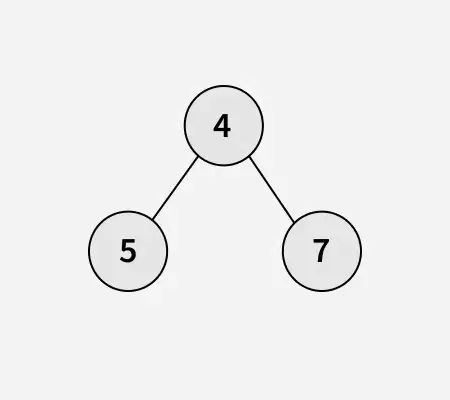Givet en n-ært træ indeholdende positive nodeværdier er opgaven at finde dybde af træet.
Note: An n-ært træ er et træ, hvor hver knude kan have nul eller mere børn noder. I modsætning til et binært træ, der højst har to børn pr. node (venstre og højre) n-ærtræet giver mulighed for flere grene eller børn for hver node.
Eksempler:
Input:
Produktion: 3
Forklaring: Den længste vej fra roden (node 81) til et blad er enten 81 -> 26 -> 95 eller 81 -> 26 -> 86, hvilket giver en maksimal dybde på 3.Input:

Produktion: 2
Forklaring: Den længste vej fra roden (node 4) til ethvert blad (node 5 eller 7) er 2, da det kun kræver to niveauer af gennemløb.hvordan man kontrollerer skærmstørrelsen på skærmen
Nærme sig:
Ideen er at beregne dybden af et N-ært træ rekursivt initialisere maksimal dybde som 0, beregnes derefter rekursivt dybde for hvert barn og holde styr på højeste dybde stødt på. Tilføj endelig 1 til den maksimale dybde (for den aktuelle node) og returner resultat . Denne tilgang sikrer, at vi finder længste vej fra roden til en hvilken som helst bladknude.
N-Ary træ kan krydses ligesom et normalt træ. Vi skal bare overveje alle børn af en given node og rekursivt kalde den funktion på hver node.
C++// C++ Code to find the depth of an N-ary tree #include
// Java Code to find the depth of an N-ary tree import java.util.*; class Node { int data; List<Node> children; Node(int val) { data = val; children = new ArrayList<>(); } } // Recursive function to calculate // maximum depth class GfG { static int maxDepth(Node root) { // If the node is null depth is 0 if (root == null) { return 0; } int depth = 0; // Recur for all children and find // the maximum depth for (Node child : root.children) { depth = Math.max(depth maxDepth(child)); } // Add 1 to include the current node // in the depth count return depth + 1; } public static void main(String[] args) { // Representation of given N-ary tree // 1 // / | // 2 3 4 // / // 5 6 Node root = new Node(1); root.children.add(new Node(2)); root.children.add(new Node(3)); root.children.add(new Node(4)); root.children.get(0).children.add(new Node(5)); root.children.get(2).children.add(new Node(6)); System.out.println(maxDepth(root)); } }
# Python Code to find the depth # of an N-ary tree class Node: def __init__(self val): self.data = val self.children = [] # Recursive function to calculate # maximum depth def max_depth(root): # If the node is None depth is 0 if not root: return 0 depth = 0 # Recur for all children and # find the maximum depth for child in root.children: depth = max(depth max_depth(child)) # Add 1 to include the current # node in the depth count return depth + 1 if __name__ == '__main__': # Representation of given N-ary tree # 1 # / | # 2 3 4 # / # 5 6 root = Node(1) root.children.append(Node(2)) root.children.append(Node(3)) root.children.append(Node(4)) root.children[0].children.append(Node(5)) root.children[2].children.append(Node(6)) print(max_depth(root))
// C# Code to find the depth of an N-ary tree using System; using System.Collections.Generic; class Node { public int data; public List<Node> children; public Node(int val) { data = val; children = new List<Node>(); } } // Recursive function to calculate // maximum depth class GfG { static int MaxDepth(Node root) { // If the node is null depth is 0 if (root == null) { return 0; } int depth = 0; // Recur for all children and find the maximum depth foreach (Node child in root.children) { depth = Math.Max(depth MaxDepth(child)); } // Add 1 to include the current // node in the depth count return depth + 1; } static void Main(string[] args) { // Representation of given N-ary tree // 1 // / | // 2 3 4 // / // 5 6 Node root = new Node(1); root.children.Add(new Node(2)); root.children.Add(new Node(3)); root.children.Add(new Node(4)); root.children[0].children.Add(new Node(5)); root.children[2].children.Add(new Node(6)); Console.WriteLine(MaxDepth(root)); } }
// JavaScript Code to find the depth // of an N-ary tree class Node { constructor(val) { this.data = val; this.children = []; } } // Recursive function to calculate // maximum depth function maxDepth(root) { // If the node is null depth is 0 if (!root) { return 0; } let depth = 0; // Recur for all children and find // the maximum depth for (let child of root.children) { depth = Math.max(depth maxDepth(child)); } // Add 1 to include the current node // in the depth count return depth + 1; } // Representation of given N-ary tree // 1 // / | // 2 3 4 // / // 5 6 const root = new Node(1); root.children.push(new Node(2)); root.children.push(new Node(3)); root.children.push(new Node(4)); root.children[0].children.push(new Node(5)); root.children[2].children.push(new Node(6)); console.log(maxDepth(root));
Produktion
3
Tidskompleksitet: O(n), da hver node besøges én gang, hvor n er det samlede antal noder i det N-ære træ.
Hjælpeplads: O(h) hvor h er højden af træet på grund af brug af rekursiv opkaldsstabel.


